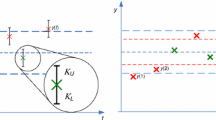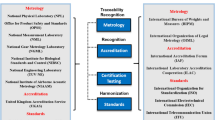Abstract
Calibration measurement capabilities (CMC) are key factors in declaring the metrological performance of national metrology institutes (NMIs). Different countries have different CMC capabilities, reflecting both the existing measurement science competence as well as the perceived national needs for traceable calibration. This paper deals with increasing interest in decision-making in conformity assessment in terms of effective costs associated with measurement, testing and incorrect decision-making. The work examines the CMCs of calibration laboratories and NMIs with economic decision theory, in particular, in terms of customer satisfaction and with respect to conformity assessment issues. Optimal strategies for calibration costs, maintenance of national measurement standards, testing and production costs are illustrated in practical examples. CMCs are an essential instrument to enable conformity assessment both for product safety, legal metrology, quality requirements as well as scientific research. The newly defined term “target measurement uncertainty”, introduced in the latest international metrology vocabulary (VIM), should be therefore always related to appropriate CMCs and related dissemination paths in the whole conformity assessment procedure. These requirements are clear and transparent justification for the development of required national metrological infrastructures, in order to fulfil the requirements of target measurement uncertainty for intended use or application in the particular conformity assessment procedure.






Similar content being viewed by others
References
Mutual Recognition Agreement of the Metre Convention MRA KCDB Internet address (2009). September 2009. http://kcdb.bipm.org/
Strouse GF, Ballico M, Bojkovski J, de Groot M, Liedberg HG, Pokhodun AI (2008) CCT WG8 CMC review protocols: development and implementation. Int J Thermophys 29(3):1193–1203
Pendrill LR (2007) Optimised measurement uncertainty and decision-making in conformity assessment. NCSLi Measure 2(2):76–86
Poposki N, Majcen N, Taylor P (2009) Assessing publically financed metrology expenditure against economic parameters. Accred Qual Assur 14:359–368. doi:10.1007/s00769-009-0583-3
Deming cycle. http://en.wikipedia.org/wiki/Shewhart_cycle
Thompson M, Fearn T (1996) What exactly is fitness for purpose in analytical measurement? Analyst 121:275–278
iMERA. http://www.euramet.org/. Accessed 2009
Beges G, Drnovsek J, Pusnik I, Bojkovski J (2002) Measurement uncertainty, traceability and evaluation of test results in testing laboratories, vol 13. Institute of Physics Publishing, Measurement Science and Technology, USA, pp 565–572
PUŠNIK, Igor, MIKLAVEC, Andraž (2009) Dilemmas in measurement of human body temperature. Instrum Sci Technol 37(5):516–530
Crow EL (1960) An analysis of the accumulated error in a hierarchy of calibrations. IRE Trans Instrum 1–9(2):105–114
Pendrill LR (2008) Operating cost characteristics in sampling by variable and attribute. Accred Qual Assur 13:619–631. doi: 10.1007/500769-008-0438-y
BIPM, IEC, IFCC, ILAC, ISO, IUPAC, IUPAP and OIML (2008) International Vocabulary of Metrology (VIM)—basic and general concepts and associated terms, 3rd edn. JCGM 200:2008. http://www.bipm.org/en/publications/guides/vim
Renaot E, Hermier Y, Bojkovski J (2008) Intercomparison of the realization of the ITS-90 from 83.8058 K to 692.677 K among European NMIs. Int J Thermophys 29(3): 991–1000. http://www.springerlink.com/content/dp51782x24248131/fulltext.pdf
Author information
Authors and Affiliations
Corresponding author
Rights and permissions
About this article
Cite this article
Beges, G., Drnovsek, J. & Pendrill, L.R. Optimising calibration and measurement capabilities in terms of economics in conformity assessment. Accred Qual Assur 15, 147–154 (2010). https://doi.org/10.1007/s00769-009-0599-3
Received:
Accepted:
Published:
Issue Date:
DOI: https://doi.org/10.1007/s00769-009-0599-3




